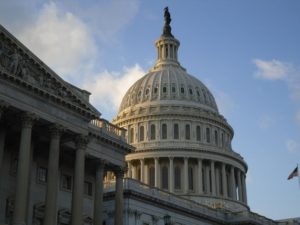April 9, 2020
President Trump recently signed into law the Coronavirus Aid, Relief, and Economic Security (CARES) Act. The $2 trillion coronavirus relief package provides  financial support for the nation’s families and working people, stabilizes the economy, provides relief for small business, supports hospitals and schools, and protects jobs.
financial support for the nation’s families and working people, stabilizes the economy, provides relief for small business, supports hospitals and schools, and protects jobs.
For agriculture, the bill provides $9.5 billion to support farmers who experience financial losses due to the coronavirus crisis, $14 billion through the Commodity Credit Corporation, $3 million to support an increase in capacity to help USDA Farm Service Agency meet increased demands from farmers, and eligibility for farmers and agricultural and rural businesses to receive up to $10 million in small business interruption loans. The bill includes nearly $350 billion for a Paycheck Protection Program (PPP) to provide small businesses with zero-fee loans for up to $10 million. The bill also includes $10 billion in funding to provide an advance of $10,000 to small businesses that apply for an SBA economic injury disaster loan (EIDL) within three days of applying for the loan.
PPP Eligibility: Agricultural producers, farmers, and ranchers with 500 or fewer employees whose principal place of residence is in the United States are eligible for the Paycheck Protection Program. Farms are eligible if the farm has 500 or fewer employees, or it fits within the revenue-based sized standard, which is average annual receipts of $1 million. Also, farms can qualify if they meet SBA’s “alternative size standard.” The “alternative size standard” is currently a maximum net worth of the business, not more than $15 million, and the average net Federal income taxes of the business for the two full fiscal years before the date of the application, not more than $5 million.
Small agricultural cooperatives and other forms of cooperatives may be eligible, provided they comply with all other Loan Program Requirements.
Payroll: Only employees with a principal place of residence in the U.S. count toward eligibility and calculation of the PPP loan amount.
Sole Proprietor Farmers: SBA requires sole proprietors, independent contractors, and other eligible self-employed individuals to provide documentation to its lender that the business was in operation as of February 15, 2020. This documentation may include payroll processor records, payroll tax filings, or Form 1099-MISC, or income and expenses from a sole proprietorship. For borrowers that do not have any such documentation, the borrower must provide other supporting documentation to its lender, such as bank records, sufficient to demonstrate the qualifying payroll amount.
Documentation options for payroll tax filings include the following:
Click here for the CARES Act section summary.
Supplemental COVID-19 legislation
Immediately following passage, lawmakers looked to the fourth COVID-19 supplemental. While initial plans were to focus on infrastructure, Speaker Pelosi signaled a shift in priorities and said that the House aims to have the bill look similar to COVID-III.
Speaker Pelosi has been adamant to maintain April 20, or soon after, as the deadline for passage. However, things remain up in the air. D.C. Mayor Muriel Bowser indicated peak COVID-19 infections could come late June/early July. This may impact the city’s shelter-in-place order and an extension of the order could impact Pelosi’s timeline. Provisions for COIVD-IV could include:
Read more in the Cornerstone Government Affairs Legislative Update.
For video, photos and other resources, view Resources.
For media inquiries or
interview requests, contact Hinda Mitchell.